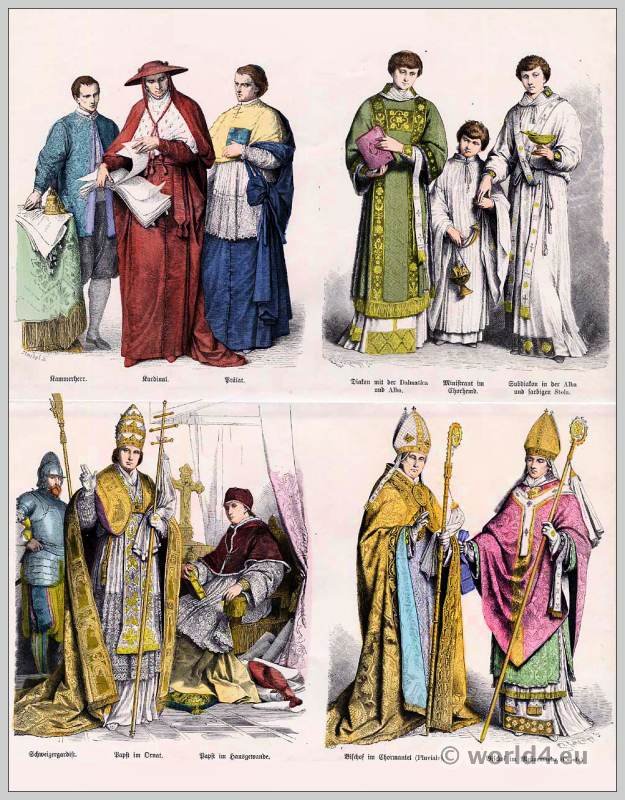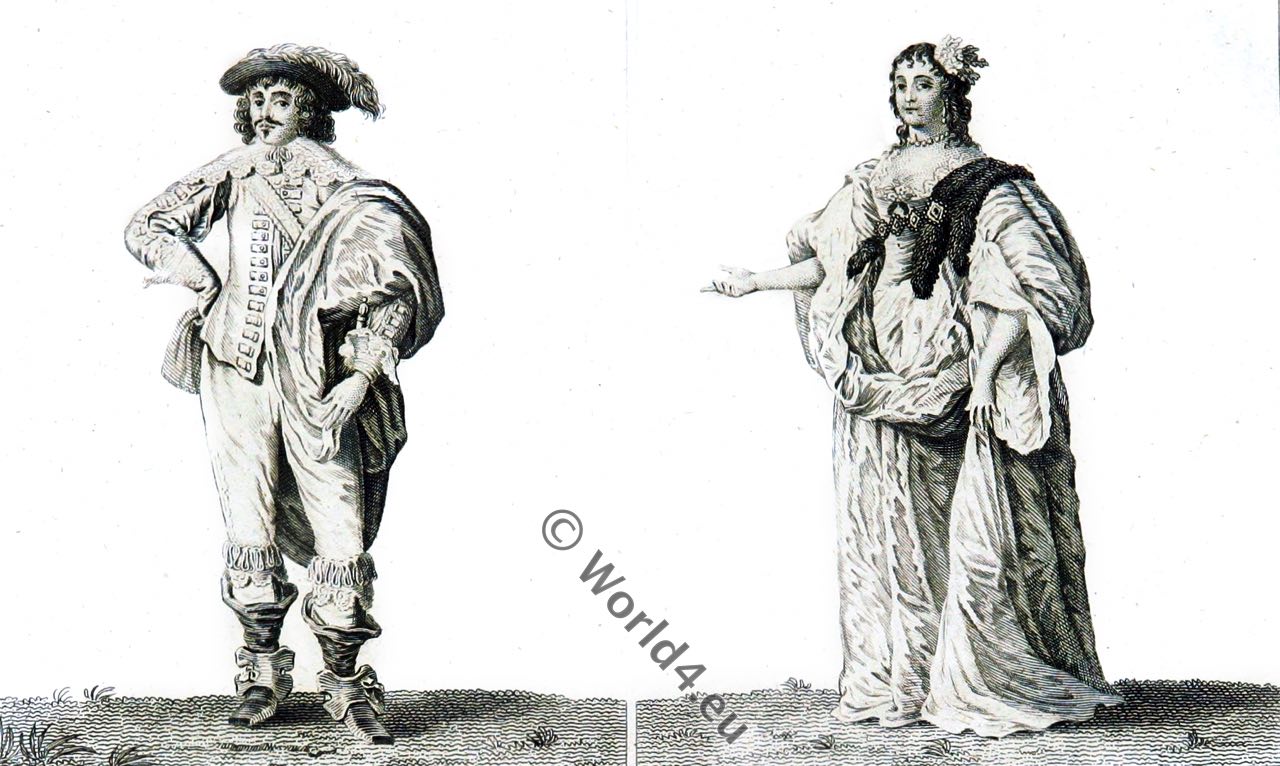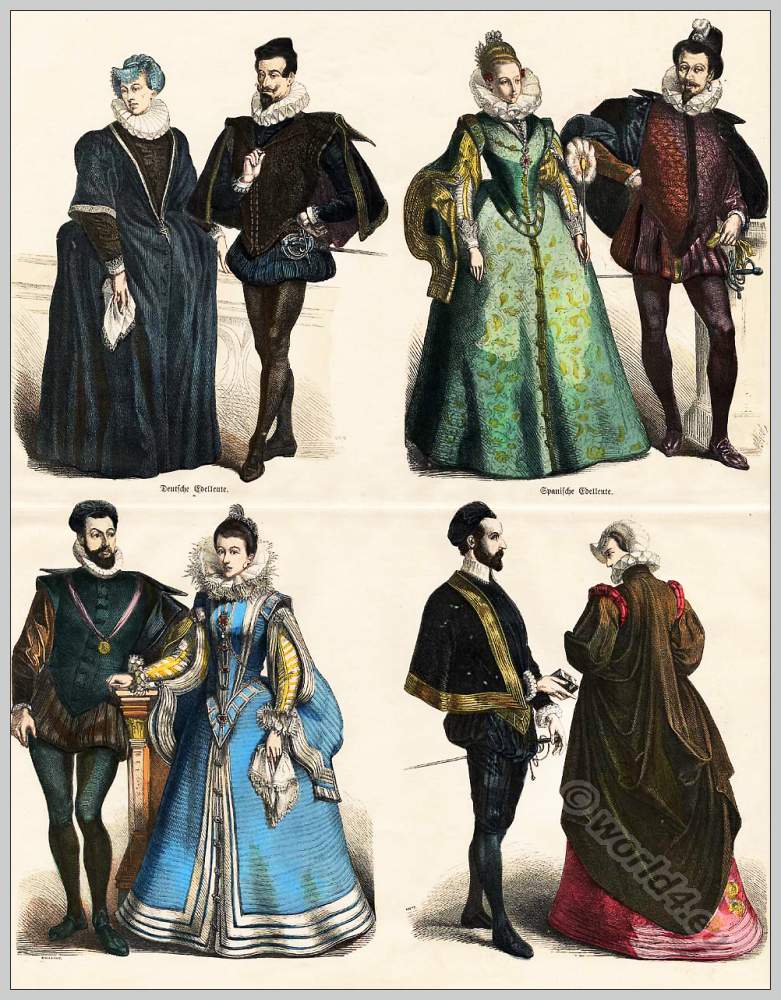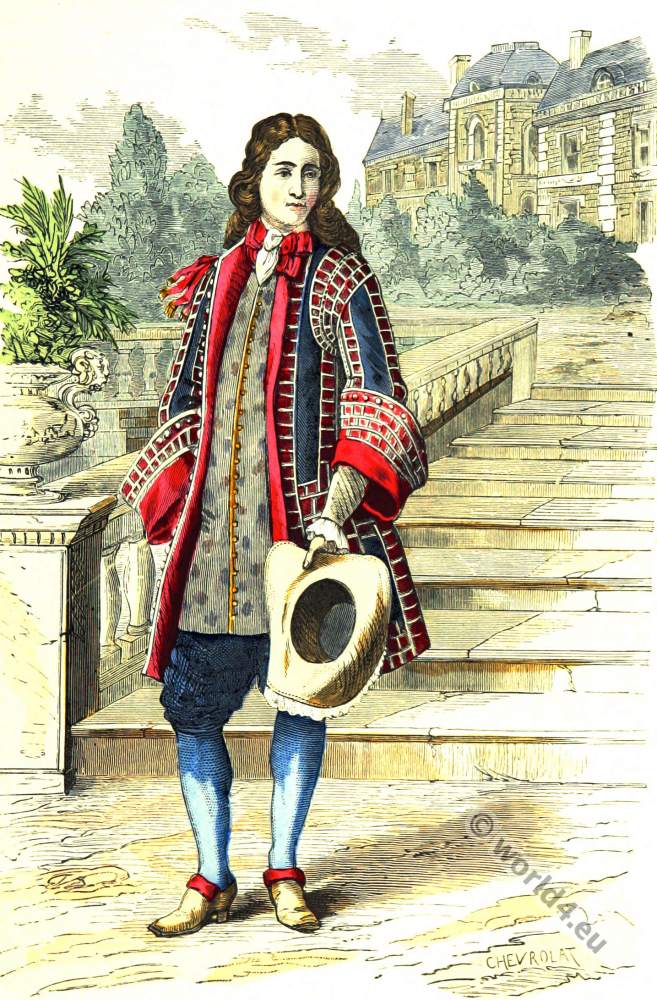
1 2
3 4 5
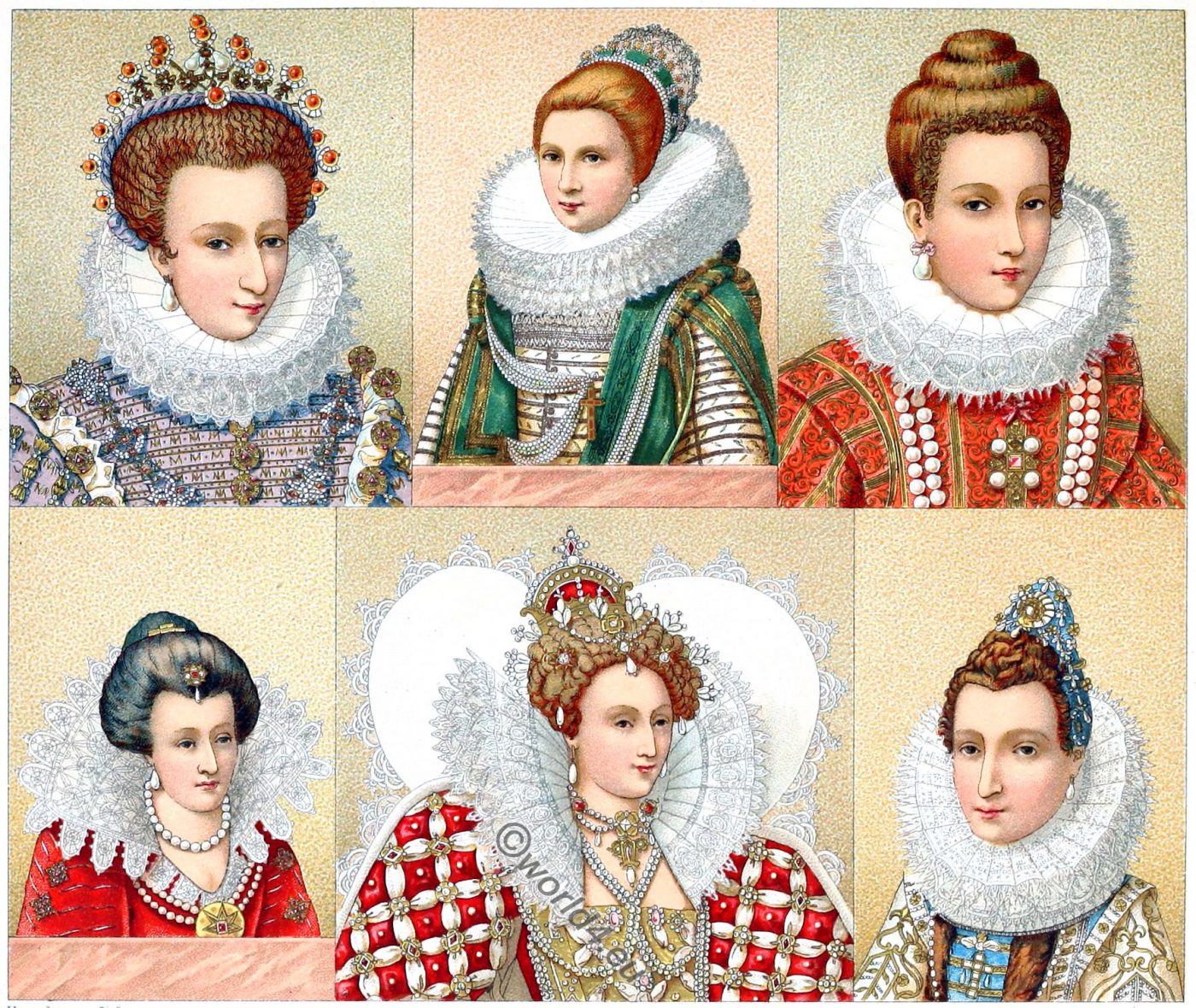
6 7 8
9 10 11
EUROPE XVI & XVII CENTURY. WOMAN’S DRESS. NECK RUFFS. HAIRSTYLES
- Numbers 1 and 2. Portrait of an unknown woman.
- No. 3 and 11. Infanta Isabella Clara Eugenia, wife of Archduke Albrecht of Austria, born 1566, died 1633.
- No. 6. Catherine of Bourbon, 1600.
- No. 7. Portrait of a Dutch woman, painted by Paul Moreelse (1571-1638).
- No. 8 and 9. Mary of Medicis, born 1573, died 1642.
- No. 10. Elizabeth of England, born 1533, died 1603
- No. 4. Parisian woman in the costume of a married woman.
- No. 5. Parisian woman, 1610.
The dresses naturalized by the Italian fashion in France, which favored the display of fine canvas by the wide necklines of the bodices, were followed by a fashion that rose more and more to the neck and was closed at the end at the top completely. The collars of the dresses gradually nestled so tightly against the neck that they deserved their name “neck iron” (carcan). The narrow, straight sleeves, reaching down to the wrist, had a shoulder piece at the top, from which a short, free-floating sleeve, the mancheron, hung down. The aim was to wear close-fitting outer garments in order to achieve, as they put it, “un corps bien Espagnol” (a good Spanish body).
Lacing the breasts of women with the help of metal and wooden splints (corset) was such “that it was sometimes, as Montaigne says, to be killed”. This tight-fitting costume of the women was a borrowing from the male costume. The connection of these bodices with the Amazon skirt is attributed to the ladies-in-waiting of Catherine of Medicis, who followed the queen mother on horseback.
As a result of one of the strangest contradictions in fashion, this completely closed garment was combined with the richest possible display of fine lingerie, which could actually only be seen at the top of the stiff collar and at the outermost end of the sleeves. Henry II is said to have introduced these closed collars to cover a scar. However, at that time it was a question of showing a fashion of a completely new kind, namely the passementerie works and laces, which spread all over Europe with the greatest speed.
The laces were originally nets of threads of gold, silver, silk, flax, cotton and hair that formed a drawing. This is the bobbin lace, which probably has its origin in the net work of the fishermen, because the bobbin lace was and is preferably native to the European coasts, especially those of the Mediterranean Sea.
Another type was sewn lace, in which individual threads were pulled out of the fabric forming the base and the resulting holes were “filled with openwork sewing (frame embroidery, the sewing out or embroidering of fabric stretched in a frame) in manifold drawings”. It is not known where the first laces were created. Reiffenberg assures that lace hoods were already in use in Belgium in the 14th century. The Italians claim the invention of sewn lace for themselves, and the Spanish do the same. According to other sources, lace was of oriental origin.
In the fashion of the 16th and 17th centuries, at any rate, they met with even greater approval, as pattern books compiled by artists appeared early on and contained instructions on how to make sewn lace. Le Livre nouveau et subtle, printed in Cologne in 1527 by Pierre Quinty, seems to be the oldest of these lace books, soon followed by a large number of others in Italy, France and Germany until the beginning of the XVII century.
The desire to show off these embroideries, which were made with such great effort, gave the lace on the close-fitting costume of the second half of the 16th century such an important place. That is why the collar, the fraise, as it was called because of its similarity to a veal chitterling, became larger and larger. Not only did its circumference resemble a millstone, but the rows of stiffened tubes, arranged in three, four and five rows in tiers one above the other, made the frill so high that the shoulders and half of the chest were covered by it.
Pierre l’Estoile said that such an isolated head would be similar to the cut-off head of John the Baptist on the bowl (the variant with tubular folds was called pipe collar.) This comparison is all the more fitting as the collar was quite stiff and was held by a metal frame. The fabric was so stiff that the ruffs crackled like paper. Eating with such a collar was a great difficulty. One had to reach for spoons and forks with long styles to get to the mouth.
Since in addition to this stiff ruffle and the tight bodice there was a drum-shaped skirt and a long overdress, which had the purpose of concealing the high soles with whose help one made oneself taller, it was no small art to maintain a good posture in this arduous costume. Moreover, since it was flirted with to show sometimes this, sometimes that of the precious petticoats or the red silk stocking, a formal study was necessary in order to follow all the rules of etiquette.
Around 1575, this fashion and at the same time the expansion of ruffs reached its peak, and it seems that their popularity spread especially in France. However, there are also personalities in other countries who have not lagged behind these extravagances or even surpassed them.
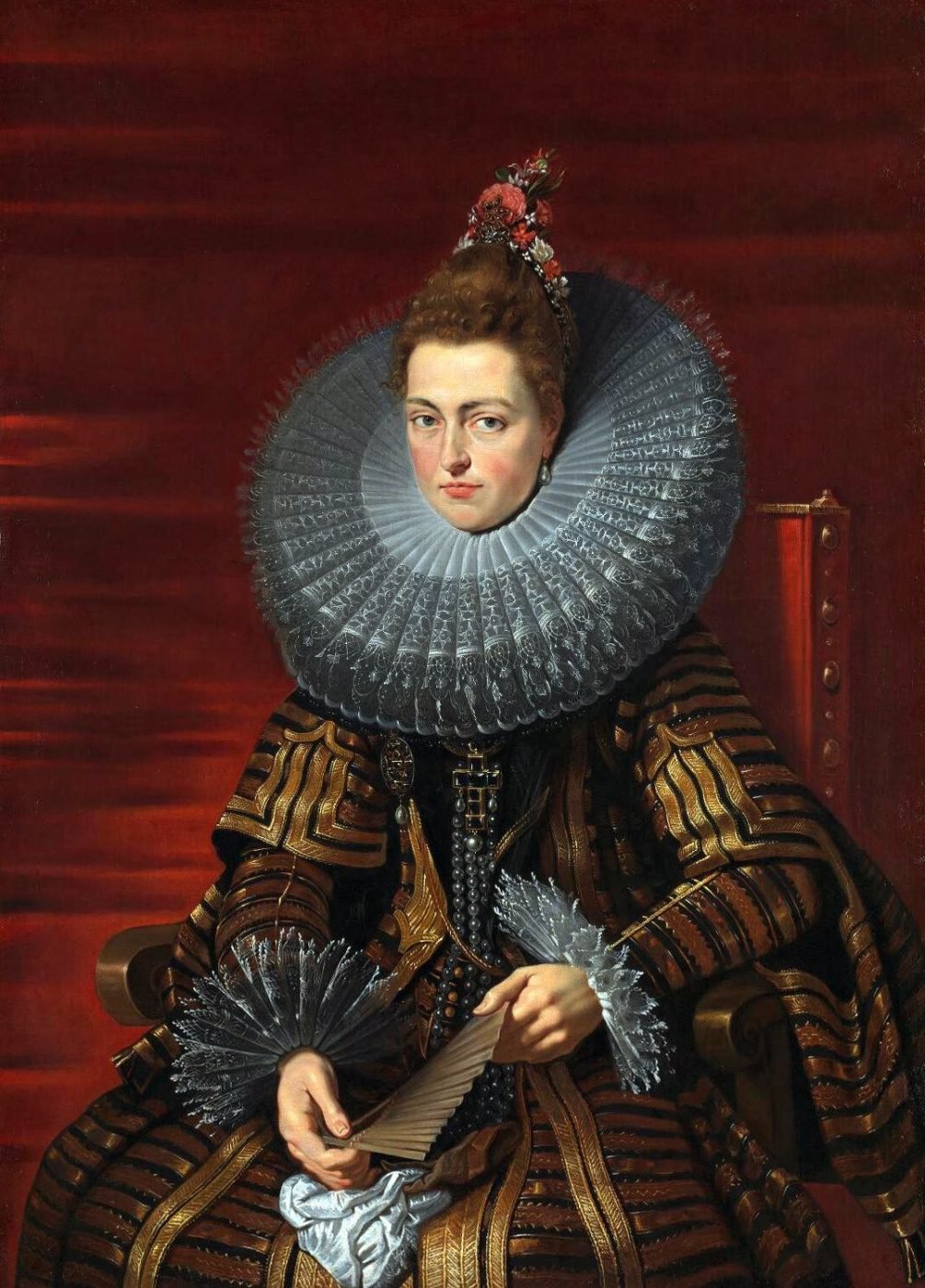
Here we present two portraits of Archduchess Isabella (Isabella Clara Eugenia of Spain 1566-1633), governor of the Netherlands, daughter of Philip II, separated by about twenty years. (No. 3 and 11.) Her two ruffs are not among the largest of those depicted here. However, there is a third portrait of this princess (above picture), on which the ruff with a diameter of fifty centimetres surpasses all our samples.
The fashion foolishness of Queen Elizabeth I of England seems to have surpassed all concepts. Without thinking of the three thousand lace-decorated robes that were in her wardrobe, one need only recall what Walpole says of her portraits: “One thinks one has before one an Indian idol, consisting only of hands and necks; a Roman nose, a mountain of hair, laden with crowns and diamonds, an immense ruff and a vast quantity of pearls. In the picture of Elizabeth I (No. 10) reproduced by us, the collar open at the front is a compromise between the round ruff and the open, fan-like arranged collar worn by Mary of Medicis (No. 9). The lace-trimmed cups rising behind Elizabeth’s head form the collar of the cloak, which is attached to the shoulder and is also richly decorated with lace.
In place of the ruff came the fan-shaped collar, which joined the neckline of the dresses as if it were a kind of lapel (No. 9). The lace trimming is wider than in the ruffs; also the collar, which was also held upright by brass wire called a supportasse or underpropper, consisted only of a row of tubes.
As you can see in No. 4 and 5, the neck and part of the chest was sometimes completely exposed by these fan collars. These simpler collars were worn by citizens who were forbidden to use lace by the laws of luxury. These collars, although used with great rigour, had to be renewed frequently. The penalties ranged from fines to public flogging by an executioner. Elizabeth I. also kept a strict regiment in England regarding the expenditure with lace. (Cf. Bury-Palliser, Histoire de la Dentelle).
The lace sleeves followed in extension and strength the development of the ruffs. When the latter were displaced by the fan collars, the lace on the sleeves also formed only simple lapels. Jewels and gold jewellery were in abundant use on the dresses.
The cutting of gemstones had taken off with the 16th century, and at the same time transparent enamel was added. Only necklaces had to be avoided in view of the ruffs. One fastened the chains, at which one hung crosses on, for it at the chest, like No. 6, 7 and 8 show. As soon as the neck became free, the necklaces also returned to their former place (No. 4, 5, 9 and 10).
The hair was powdered, but the powder was not applied dry, but by means of a plant sap. If one wanted to comb the hairs back together, one had to do several washes to get through with the comb. People also wore wigs, even flax ones. Rings of strong wire were used to raise the hair above the temples like a toupee. Small balls of felt were also used, which were placed under the hair to pull it up so that the forehead became quite wide and high. Or, with the help of these pads, hair was used to build several floors or artificial buildings in the form of apples, pears or gable roofs.
No. 1, 2 and 3 after paintings in the possession of Messrs Baur and Gavet. – No. 4 and 5 from the collection of Josse de Bosscher, 1610. No. 6 and 7 after engravings by Jan Wierisx. No. 9 by H. Jacobsen, No. 10 by Crispin van den Queboren, No. 11 by de Clerck.
Source: History of the costume in chronological development by Auguste Racinet. Edited by Adolf Rosenberg. Berlin 1888.
Related
Discover more from World4 Costume Culture History
Subscribe to get the latest posts sent to your email.


